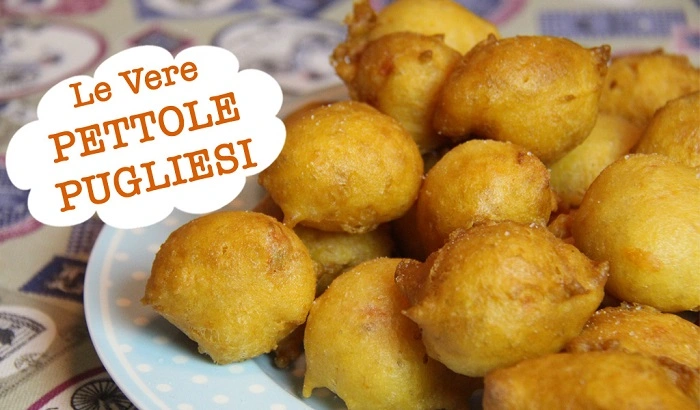Picture a winter’s night in December, cold to the point of bitterness in southern Italy. Laughter, music, light in the streets. There are tables and families, seated around them. There are plates of golden fried dough balls, puffed and airy, sometimes sweet, sometimes savory. They are pettole, a seasonal specialty that warms the heart.
Pettole are simple: flour, yeast, water, and salt. The dough is leavened, then fried in hot oil until golden and swollen. Plain, they are consumed, sugar sprinkled over them, anchovies filled inside, or honey sweetened. Pettole are the culmination of family, celebration, and tradition in Puglia, Calabria, and Basilicata.
Table of Contents
Fractions in Pettole: Finding Meaning
Pettole can be described as fractions of celebration.
- 1 entire bowl of pettole = family dinner.
- 1/2 bowl = best to split two ways.
- 2/3 bowl = perfect for kids at a party.
- 1 3/4 cups of flour = the classic amount to produce one small batch.
The measurement for each ingredient is important. Too little yeast, no rising pettole. Too much oil, oily pettole. All about balance.
Translating the Flavors
Pettole can taste and differ by region.
- Salt pettole will have anchovies, olives, or herbs added on top of the filling.
- Sweet pettole will be drizzled with honey, sugar, or cinnamon.
- Plain pettole should be served hot from the skillet.
The base is the same but you can play around with topping and filling based on your mood.
Breaking the Balance of Cooking

Pettole is all texture: crunch on the outside, soft on the inside. To get that balance, every ingredient has a role to play.
- Flour = structure.
- Yeast = air and lightness.
- Water = tenderness.
- Salt = balance of flavors.
- Oil = golden crispy finish.
Combine the fractions, and you have an ideal pettole.
Kitchen Shortcuts with Pettole
Pettole preparation can be simple, but shortcuts make it simpler.
- No fresh yeast on hand? Use dry yeast.
- No honey? Use sugar or syrup.
- No anchovies? Use cheese or skip them.
These substitutions render the character of pettole shortcut-friendly.
Why Pettole Are Important to Culture
Pettole are something more than bread. Pettole are memory and tradition.
- They are consumed in Puglia on December 8th, Feast of the Immaculate Conception.
- They are prepared by families at Christmas and New Year’s celebrations in Calabria.
- They are offered to neighbors as a sign of friendship in Basilicata.
Pettole are special in that they transform plain dough into an act of coming together.
Real-Life Recipes using Pettole
- Classic Pettole: Fried dough balls consumed in its plain state.
- Sweet Pettole with Honey: Add honey or sugar while hot.
- Salty Pettole with Anchovies: Place bits of anchovy in every ball of dough.
- Pettole with Olives: Add chopped olives to dough prior to frying.
These recipes demonstrate how from one base, you can create numerous dishes.
Measuring Pettole in Tablespoons
If you are a perfectionist, measure pettole dough in tablespoons.
- 1 cup flour = 16 tablespoons.
- 1 3/4 cups flour = 28 tablespoons.
- 1 packet yeast = approximately 2 1/4 teaspoons.
- 1 pettole ball, medium = about 2 tablespoons dough.
Makes doubling the batch simple.
Thinking Ahead with Water
Consider the cups of dough water.
- Two scoops of flour.
- One scoop of water.
- Half scoop yeast mix.
- Pinch salt.
Mix, rise, fry. The dough magically transforms into golden pettole.
Learning with Pettole
Pettole also makes great teaching tools for children on how to cook and have patience.
- Demonstrate how the yeast makes the dough rise.
- Have them spoon small amounts into the hot oil (with help).
- Taste and compare sweet and savory toppings.
This makes cooking a family activity.
Pettole Mistakes


- Frying before hot oil. The dough will be heavy and greasy.
- Too much flour. The pettole will be heavier, not light.
- Not letting the dough rise. Without air, they are no longer light and fluffy.
The secret is patience. Allow the dough, and the oil to steady heat.
Also Read: Legal Support for Dentists Made Easier with Wood and Delgado
Why Recipes Specify Exact Flour Amounts
Most recipes require 1 3/4 cups or 2 cups of flour. These fractions are not random. They give exactly enough dough to make a family-sized batch with none left over.
- Too little flour = not enough dough to go around.
- Too much flour = too thick of dough to fry.
The quantities matter where tradition and flavor are involved.
Quick Conversion Table
- 1 cup flour = 16 tablespoons
- 1 3/4 cups flour = 28 tablespoons
- 1 tablespoon yeast = about 3 teaspoons
- 1 pettole ball = 2 tablespoons dough
- 10 pettole = about 1 1/4 cups flour
This makes it easy to scale down recipes.
FAQs on Pettole
- Q: What is in pettole?
A: Flour, yeast, water, salt, and frying oil. - Q: Are pettole sweet or savory?
A: Both. They can be topped with honey, sugar. Or they are filled with cheese, olives, or anchovies. - Q: When do people have pettole, and on which occasion or at what time of the day?
A: Traditionally during Christmas, but especially on December 8, but also on family reunions. - Q: Do pettole have to be made ahead of time?
A: Best fresh, but can be restored in the oven. - Q: What is the best oil to fry with?
A: Olive is traditional. Vegetable oil is good too.
Last Thoughts
Pettole are more than fried dough. There is tradition, flavor, and joy in every bite. They are a lesson in proportion: flour, yeast, water, and oil in harmony amounts doing their thing.
From sweet honey-topped pettole to salty anchovy-filled ones, they’re on every table. They bring families and friends together as they’ve been doing for centuries in southern Italy.
Pettole are simple to cook, but what you learn is full of tradition. With a bowl of dough and a pot of hot oil, you’re not cooking food, you’re cooking memory.

